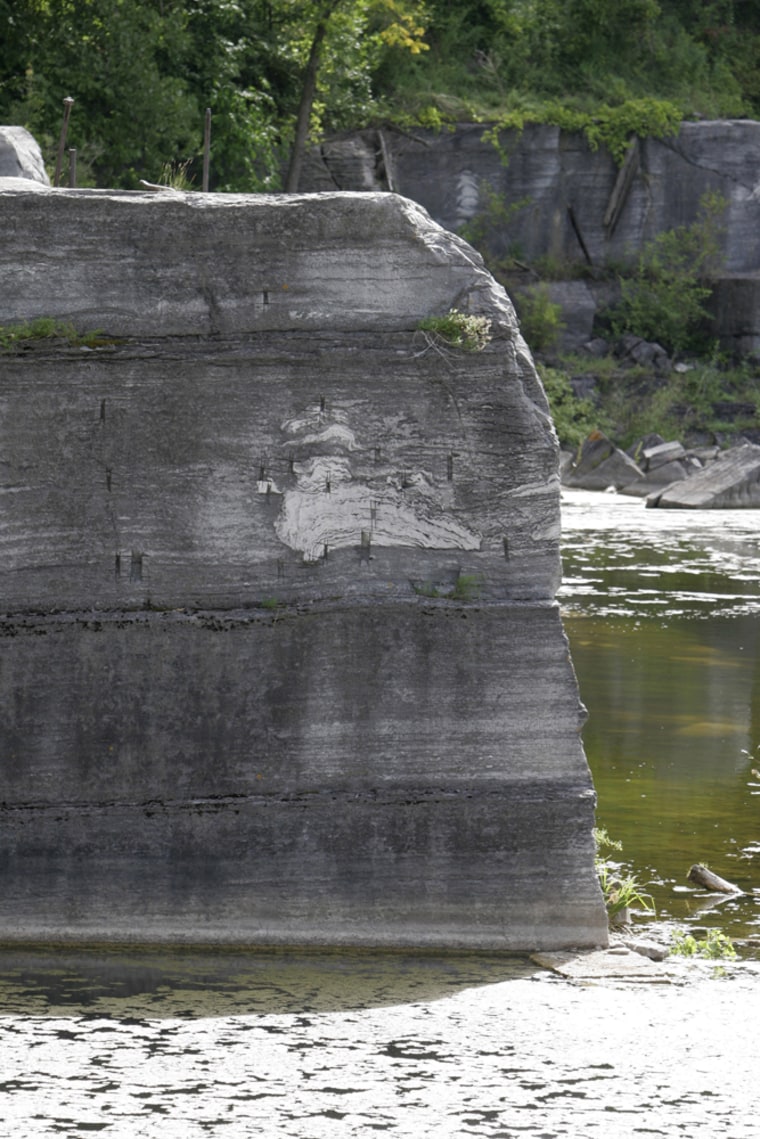To the uninitiated, the flat rock slabs found across the center of this island at the northern end of Lake Champlain appear to be nothing more than giant stones.
But the rocks offer a history of the last half billion years of this area, which was washed by a warm equatorial sea and saw long-extinct plants and animals congregate in what is believed to be the earliest ancestor of modern coral reefs.
The walls of the now-preserved Fisk Quarry offer a vertical timeline — in stone — of the different layers of fossilized plants and animals that inched their way north as the world's continents drifted into their present locations.
Visitors to the 81-acre Goodsell Ridge Fossil Preserve here can use a trail that will lead to the fossilized remains of cephalopods, an ancestor of present-day squids; stromotoporoids, a cabbage-like animal that was the primary builder of the reef; and early snails known as gastropods.
Some of the fossils are as big as a playing card, others can be seen only with a magnifying glass.
"As we walk through the Goodsell Ridge, we'll be able to actually walk across their tops, which would be very similar to what you'd see if you were snorkeling over them 480 million years ago," said Charlotte Mehrtens, chair of the geology department at the University of Vermont, who has studied the reef for decades.
The rocks sticking through the surface on Isle La Motte were part of a geologic formation that once ran from Newfoundland to Tennessee and Virginia. The area, known as the Chazy Reef, has attracted geologists from across the world.
"There is something unique about the environment here in Vermont, where the reef diversity was very high, meaning there are lots of different kinds of organisms, lots of different kinds of species," said Mehrtens.
"On top of that, those species changed over time, so the organisms that built the oldest layers of the reef are different from the organisms that built the middle layers and are different from the organisms that built the youngest layers."
The area offers a perfect example of what geologists call biological succession, where one species is followed by another.
In the beginning
To geologists, the Chazy Reef is unique. "It is the first and most extensive reef that was ever built in the earth's history by the phylum briozoa," said Roger Cuffee, a professor of paleontology at Penn State University, who has studied the Lake Champlain reef for decades.
Briozoas are a line of animals that evolved from soft-bodied invertebrates like sponges. They predate coral reefs by about 30 million years. "Think miniature coral and think the seacrust crud on shell and rocks growing in shallow water when you wade into tidal pools," Cuffee said.
Now, that area will remain accessible to the public forever. The Isle La Motte Preservation Trust has been working with the Lake Champlain Trust to raise $400,000 to buy the land on Goodsell Ridge and open a visitor center in a renovated farmhouse.
"It's this wonderful sort of museum of creation and of evolution," said Peter Espenshade of the Lake Champlain Land Trust. "It really sort of sparks the wonder and the mystery of things, when you think of something that was alive half a billion years ago, that was alive before there was life on land."
Isle La Motte is a 3-by-7-mile island near where Lake Champlain empties into the Richelieu River in Quebec.
French soldiers first started pulling rock from what is now the Fisk Quarry in 1666, to help them build a fort on the northwest side of the island. Early English settlers started quarrying around 1800 and the Fisk Quarry closed around 1919, said Linda Fitch, of the Isle La Motte Trust, whose family has owned land on the island since 1970.
About a century ago, state geologist Raymond Percy recognized the importance of the area and throughout the mid-part of the last century scientists crisscrossed the island, Mehrtens said.
There is still a working quarry on the land. Isle La Motte is known for its dark limestone, which has been used to build the National Gallery of Art in Washington and New York's Radio City Music Hall, said Fitch.
She first learned the significance of the area after tagging along with a geologist showing it to some adult students. She got interested in preserving the 20-acre Fisk Quarry when a businessman tried to reopen the quarry, which was preserved in 1999. It now attracts about 3,000 people a year.
Last year, the Isle La Motte Trust, with help from the Lake Champlain Land Trust, bought the land that is now the Goodsell Ridge Fossil Preserve, where visitors are able to tour the geologic history of the reef on a series of trails mowed through the grass that covers the island between the rock outcroppings.
"The stone as it is in the reef is a national conservation treasure. It's one of a kind," Fitch said. "It's the one place you can answer certain fundamental scientific questions."
